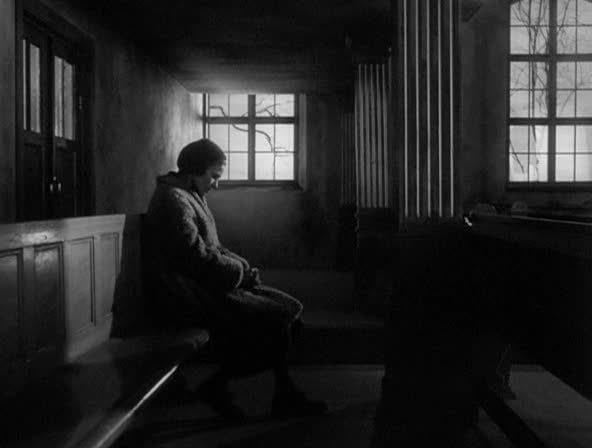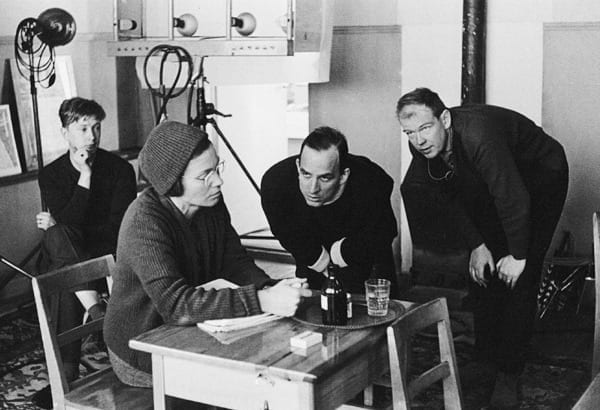

“My basic concern in making them was to dramatize the all-importance of communication, of the capacity for feeling. They are not concerned—as many critics have theorized—with God or His absence, but with the saving force of love. Most of the people in these three films are dead, completely dead. They don’t know how to love or to feel any emotions. They are lost because they can’t reach anyone outside of themselves.” — Ingmar Bergman, 1972
“In fact, the conviction that the world and man is something that had better not have been, is of a kind to fill us with indulgence towards one another. Nay, from this point of view, we might well consider the proper form of address to be, not Monsieur, Sir, mein Herr, but my fellow-sufferer, Socî malorum, compagnon de miseres! This may perhaps sound strange, but it is in keeping with the facts; it puts others in a right light; and it reminds us of that which is after all the most necessary thing in life — the tolerance, patience, regard, and love of neighbor, of which everyone stands in need, and which, therefore, every man owes to his fellow.” — Arthur Schopenhauer, “On the Sufferings of the World,” 1839
I’ve argued before that Bergman’s films are often misread as essentially symbolist. I was first introduced to this argument, and taken much further, by Susan Sontag’s notorious 1966 essay “Against Interpretation,” in which Sontag argues that, when considering Bergman’s 1963 film The Silence, “those who reach for a Freudian interpretation […] are only expressing their lack of response to what is there on the screen.” She goes on, summarizing her entire thesis, “it is always the case that interpretation of this type indicates a dissatisfaction (conscious or unconscious) with the work, a wish to replace it by something else.” Discussing Bergman’s use of symbols in Wild Strawberries I wrote,“[w]ith Bergman, just as it’s true of our capacity to dream and our compulsion to remember, we feel the symbols before we intellectualize them.” Six years after Wild Strawberries, the height of Bergman’s symbolist flirtations, Bergman finished Winter Light. A hollowing out of Bergman’s attachment to transparent allegory and symbolic play, Winter Light is a film that, nonetheless, has been limited by its popular interpretations.
When I first saw Winter Light, what impressed me most was its orderly, simple formal and narrative structures. It seems like an angular film, geometric and diagrammatic. The cinematography from frequent Bergman collaborator Sven Nykvist is minimalist, use of tripods, long single-takes with no camera movement, a study. Now that I re-watch the film, what strikes me most are its performances and its naked emotionalism. Its privacy and its stinking hopelessness and loneliness, how much the film is regarding the pain of its characters. I’ve heard Winter Light, and broadly all of Bergman’s work, discussed as a metaphor for a crisis in faith, doubt, and some vague Christian longing. But there is very little broad about Bergman nor is there anything so vague. The cold sterility of Nykvist’s cinematography stands in, not for a dispassionate intellectual apprehension, a sort of dialectic, but instead it stands in for a lonely perspective, a disconnected emotional distance, lonely like Bergman’s characters, each totally disconnected from one another and so the world.
What can at first appear as a clear stylistic strategy or a plain symbol can become, in a Bergman film, an emotional pathway. Bergman is as clear as any filmmaker, his intentions are to invoke a feeling, not to referee a discussion on the existence of God. Yet many of his films invite interpretation and contextualization, where our presuppositions confront the text and we can reduce a film to an interpretation, or in Sontag’s language, “replace” the film with something else. Resisting the interpretation, I have found, is the key to Bergman’s greatest talents as a filmmaker, not a symbolist but a humanist.
A short plea to (re)visit Bergman’s second masterpiece: Winter Light, perhaps more than any of his films, highlights this humanist stance, concentrates so carefully on it. The film rests on person-to-person conversation; very little action is involved. The film concerns a parish and its priest, concerns human relationships forbidden by social custom, concerns loneliness and desperation, concerns the fear of not being loved and of being unable to love, concerns suicide. A deeply personal film for Bergman, Winter Light was among a handful of rare screenplays Bergman ever entrusted to his father Erik Bergman, Church of Sweden minister, to read. The rest of his life and career, Bergman counted Winter Light as his favorite of his films. To quote Bergman, “I think I have made just one picture that I really like, and that is Winter Light.”
Please enjoy these photographs of Bergman collaborating on the set of Winter Light:



Winter Light is playing at Indiana University Cinema on Nov. 18th at 1 pm. This screening will conclude the short retrospective Bergman in the ’60s, programmed as a celebration of the filmmaker’s 2018 centennial. Hope to see you all there! 🙂
 Nathaniel Sexton enjoys the films of Andrzej Żuławski, Alex Ross Perry, and Jerry Lewis. He reads comic books, plays pinball, prefers his movies sad or slow, and volunteers at a video rental store. He likes to travel west by car but always misses movies when living out of a tent.
Nathaniel Sexton enjoys the films of Andrzej Żuławski, Alex Ross Perry, and Jerry Lewis. He reads comic books, plays pinball, prefers his movies sad or slow, and volunteers at a video rental store. He likes to travel west by car but always misses movies when living out of a tent.